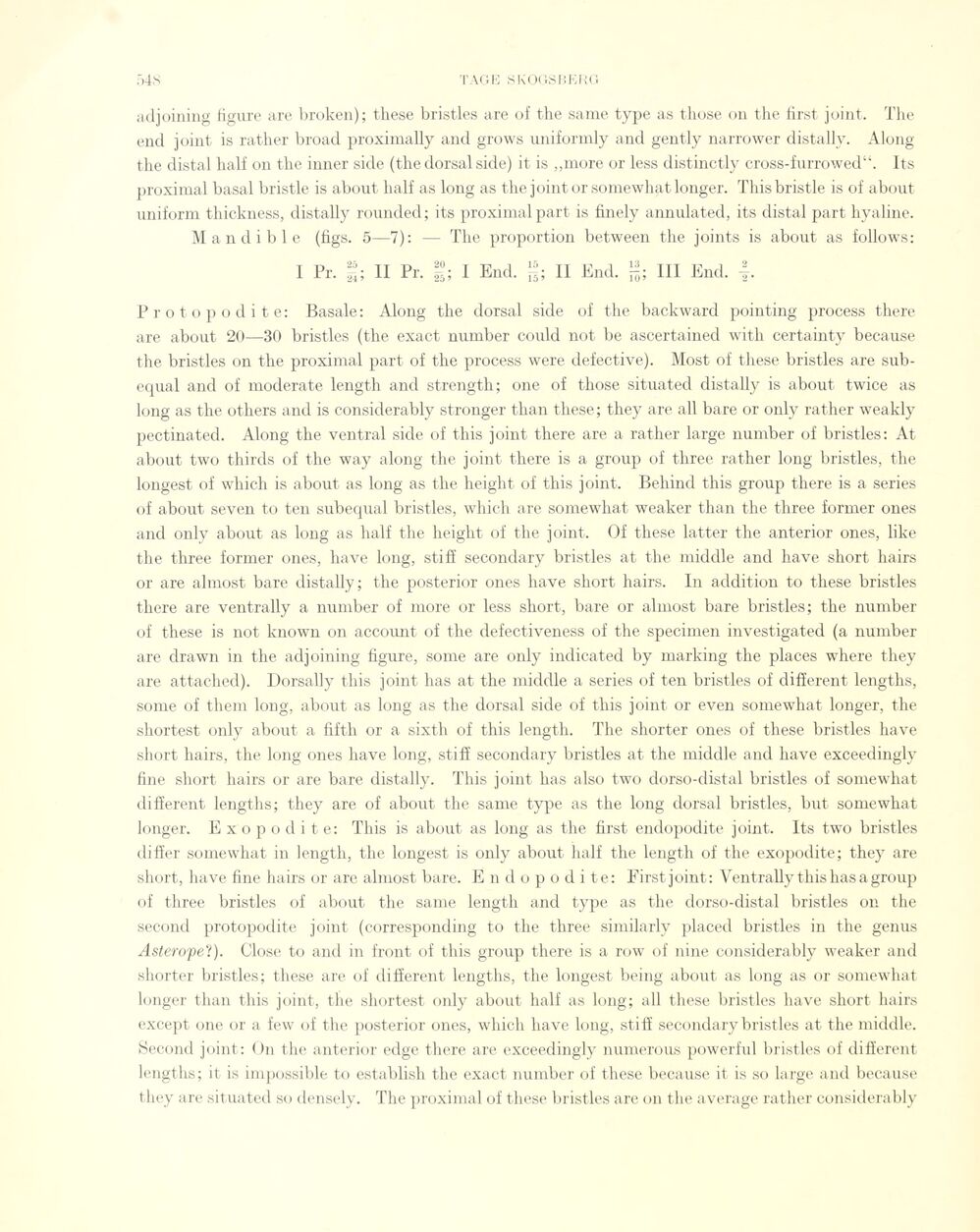
Full resolution (JPEG) - On this page / på denna sida - Sidor ...

<< prev. page << föreg. sida << >> nästa sida >> next page >>
Below is the raw OCR text
from the above scanned image.
Do you see an error? Proofread the page now!
Här nedan syns maskintolkade texten från faksimilbilden ovan.
Ser du något fel? Korrekturläs sidan nu!
This page has never been proofread. / Denna sida har aldrig korrekturlästs.
adjoining figure are broken); tkese bristles are of the same type as those on the first joint. The
end joint is rather broad proximally and grows uniformly and gently narrower distally. Along
the distal half on the inner side (the dorsal side) it is „more or less distinctly cross-furrowed“. Its
proximal basal bristle is about half as long as the joint or somewhat longer. Thisbristle is of about
uniform thickness, distally rounded; its proximal part is finely annulated, its distal part hyaline.
Mandible (figs. 5—7): — The proportion between the joints is about as follows:
1 Pr. f,; II Pr. 1 End. H End. [£; III End. |.
Protopodite: Basale: Along the dorsal side of the backward pointing process there
are about 20—30 bristles (the exact number could not be ascertained with certainty because
the bristles on the proximal part of the process were defective). Most of these bristles are
sub-equal and of moderate length and strength; one of those situated distally is about, t.wice as
long as the others and is considerably stronger than these; they are all bare or only rather weakly
pectinated. Along the ventral side of this joint there are a rather large number of bristles: At
about two thirds of the way along the joint there is a group of three rather long bristles, the
longest of which is about as long as the height of this joint. Behind this group there is a series
of about seven to ten subequal bristles, which are somewhat weaker than the three former ones
and only about as long as half the height of the joint. Of these latter the anterior ones, like
the three former ones, have long, stiff secondary bristles at the middle and have short hairs
or are almost bare distally; the posterior ones have short hairs. In addition to these bristles
there are ventrally a number of more or less short, bare or almost bare bristles; the number
of these is not known on account of the defectiveness of the specimen investigated (a number
are drawn in the adjoining figure, sonie are only indicated by marking the places where they
are attached). Dorsally this joint has at the middle a series of ten bristles of different lengths,
some of them long, about as long as the dorsal side of this joint or even somewhat longer, the
shortest only about a fiftli or a sixth of this length. The shorter ones of these bristles have
short hairs, the long ones have long, st.iff secondary bristles at the middle and have exceedingiy
fine short hairs or are bare distally. This joint has also two dorso-distal bristles of somewhat
different lengths; they are of about the same type as the long dorsal bristles, but somewhat
longer. Exopodite: This is about as long as the first endopodite joint. Its two bristles
differ somewhat in length, the longest is only about half the length of the exopodite; they are
short, have fine hairs or are almost bare. Endopodite: First joint: Ventrally this has a group
of three bristles of about the same length and type as the dorso-distal bristles on the
second protopodite joint (corresponding to the three similarly placed bristles in the genus
Asterope?). Close to and in front of this group there is a row of nine considerably weaker and
shorter bristles; these are of different lengths, the longest being about as long as or somewhat
longer than this joint, the shortest only about half as long; ail these bristles have short hairs
except one or a few of the posterior ones, which have long, stiff secondary bristles at the middle.
Second joint: On the anterior edge there are exceedingiy numerous powerful bristles of different
lengths; it is impossible to establish the exact number of these because it is so large and because
they are situated so densely. The proximal of these bristles are on the average rather considerably
<< prev. page << föreg. sida << >> nästa sida >> next page >>